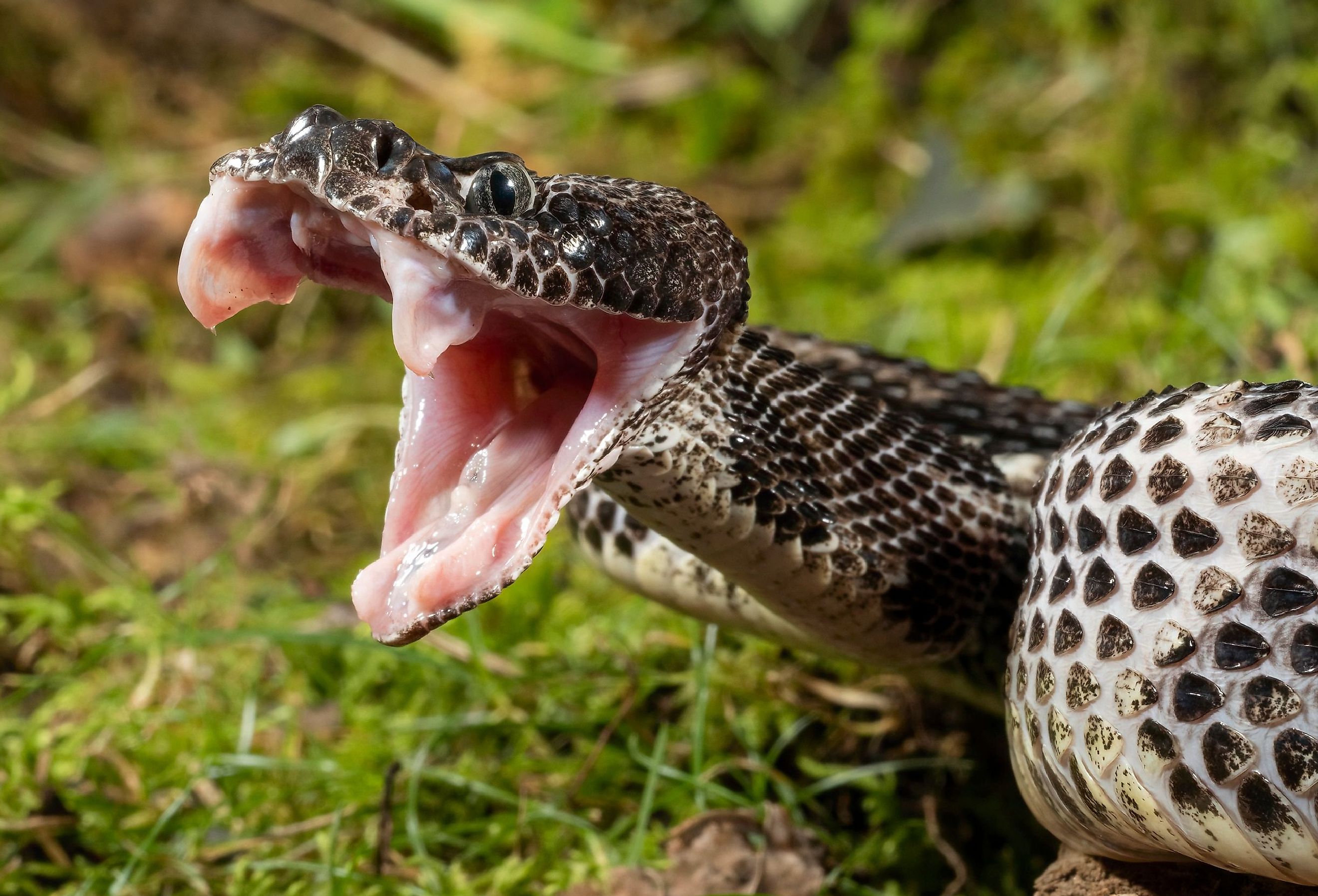
The Venomous Snakes Of Oklahoma
Travelers who love to visit new states in the US may find plenty of worthwhile destinations and ideas when considering the South Central region. States like Oklahoma are a must-visit in the region, as it boasts iconic landmarks and quirky sights that will always bring smiles to familiar or unfamiliar faces. While the state offers vibrant getaway amenities, it also has wildlife and dangerous reptiles lurking about, particularly snakes. These venomous slitherers in the "Sooner State" are the ones to look out for!
Broad-Banded Copperhead
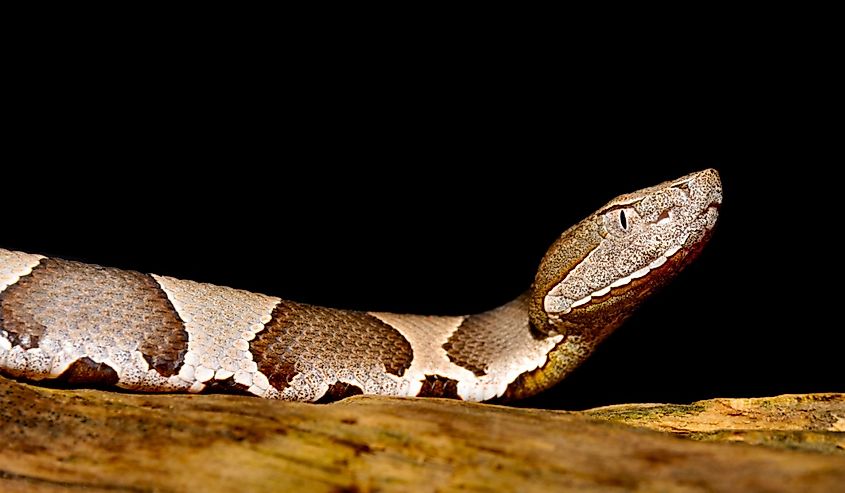
The Broad-Banded Copperhead, or Agkistrodon contortrix laticinctus, is named for its copper-red pigments and light tan body coloration. The reptile is unique for its less thin bands across the spine within the Copperhead subspecies. Copperheads like these are known for using their tails to attract food and prey; they also enjoy wiggling their bodies like a caterpillar to attract unsuspecting victims. They measure about 2 to 3 feet in length and typically have banding narrows with hourglass designs.
These Copperheads in Oklahoma are usually also found in Kansas and Texas. Still, in terms of population, they can appear around temperate broadleaf environments, mixed forest habitats, and coniferous areas near rural or suburban greenery. It is also hard to spot them within fall foliage since they love to camouflage or blend in with ground debris or fallen leaves. Their favorite prey is mostly rodents, insects, and frogs. These reptiles enjoy injecting venom-filled bites, thus making them venomous snakes that love to rattle when provoked. This species is not one to mess with as they can generate localized pain, swellings, blisters, and even convulsion symptoms for humans who try to get too close.
Desert Massasauga
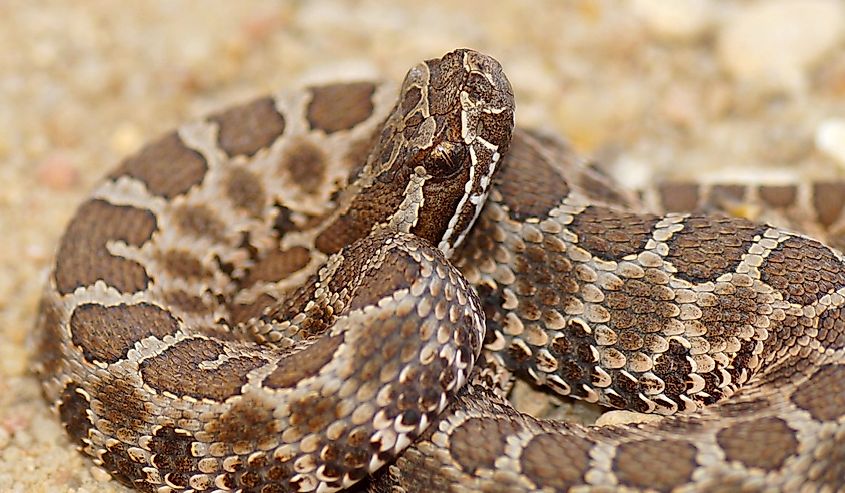
Desert Massasaugas (Sistrurus catenatus edwardsii) are reptiles of the Viperidae family that measure 1.5 to 2.5 feet in length and are known for their heavy bodies that are marked with dark brown blotches across their spines. They have crossbands that appear on the tail and are usually outlined in black with a rattle on their tail. Two stripes going down to the neck area make it easy to spot them from others. They possess elliptical pupils, and just as other pit vipers do, they enjoy using their heat-sensing nostril pits.
These primitive rattlesnakes are easy to find across Arizona, Colorado, Kansas, New Mexico, Texas, and, of course, Oklahoma. They enjoy thriving in prairie environments like buffalograss and grama, with ways to hibernate inside rodent or black-tailed prairie dog burrows when it comes to isolation or colder climates, making them more likely to be fans of secretive rural areas. These snakes prefer lizards, mammals, centipedes, and sometimes frogs or toads. The Desert Massasauga is a venomous creature that can cause cytotoxic harm to humans by destroying tissue with its bites and can also create blood clots if not treated promptly!
Osage Copperhead
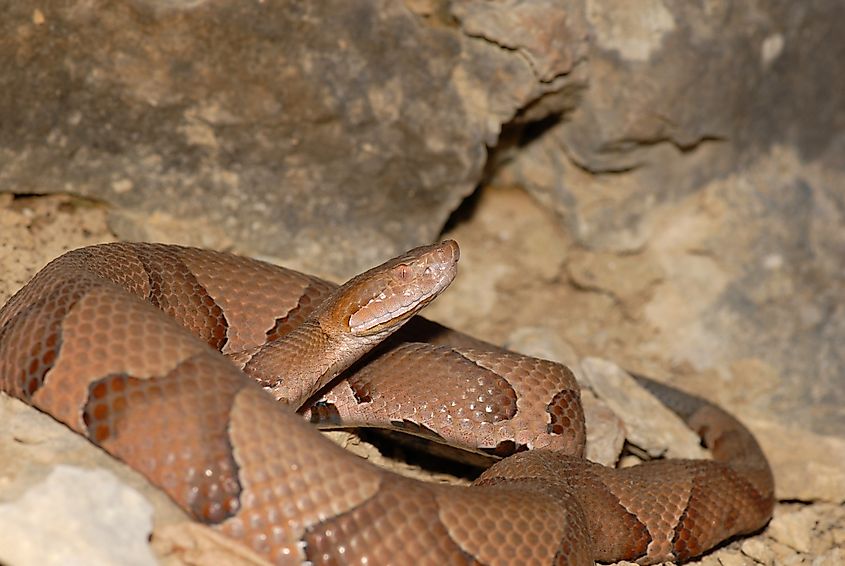
The Osage Copperhead, scientifically referred to as Agkistrodon contortrix phaeogaster, is a light tan snake similar to the Broad-Banded species but has a unique aspect with its clear yellow coat instead of being black. These species are greenish-yellow with similar wiggling formations to Broad-Banded ones, but they are also possible to find without any spotted marks or blotches. The tips of their tails are meant to wiggle to trick nearby predators into thinking they are "juicy worms." These snakes measure the same as Broad-Banded types at 2 to 3-foot lengths.
The Osage is spottable in states like central and eastern Oklahoma, alongside Iowa, Kansas, Illinois, Missouri, and Nebraska. Such Copperheads are more visible when there are woodlands and brushy meadows around. They are not as nocturnal as they are daylight roamers since they prefer cooler climates during the day and hotter temperatures at night. Cicadas, small birds, and amphibious creatures are the best meals for these reptiles. While atypical biters are caused by non-fatal venom that impacts healthy human adults, these venomous snakes are not likely to cause immense harm at first. Still, they can create severe pain reactions and necrosis for younger or smaller-sized victims like pets and children.
Prairie Rattlesnake
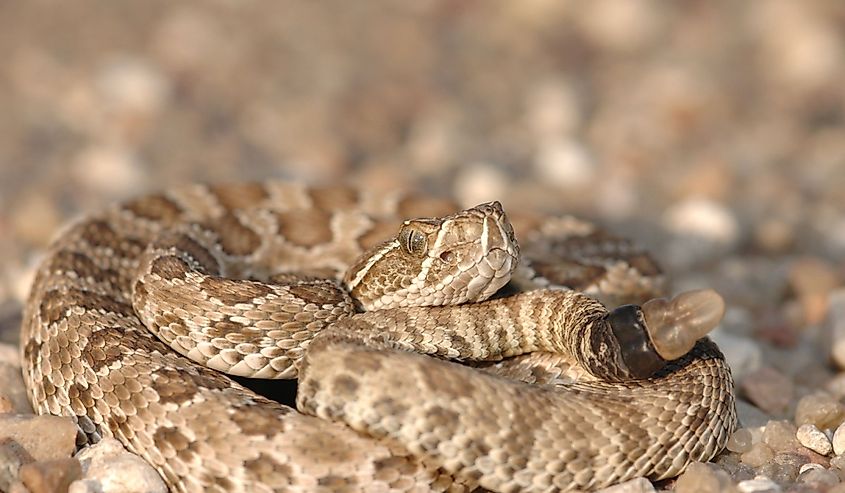
The Prairie Rattlesnake, or Crotalus viridis, is a venomous species in Oklahoma, Arizona, Colorado, Kansas, Idaho, Montana, Nebraska, Texas, Utah, Wyoming, and a few other states. These snakes are very noticeable in the open with oval, squarish, or hexagonal dark brown blotches along the spine and ringing tails. These snakes measure 1.5 to 5.5 feet in length and are known for preying on small mammals, lizards, and ground avians. They prefer grasslands, rocky outcrop dwellings, and sometimes even prairie dog towns; they are big fans of wintry seasonal habitats and enjoy wooded mountainous areas with moderate vegetation.
As they are a widespread presence within temperate zones and coniferous forests, the Prairie Rattlesnake is quite aggressive if one gets too close, so humans should always beware of this one! They like to defend themselves fairly quickly if angered or provoked and will resort to venomous bites. Its hemotoxic and cytotoxic bites are extremely potent, with venomous injections ranging from 20% to 55% in one sting, causing immediate numbness, tingling, vomiting, and similar symptoms that require medical attention.
Southern Copperhead
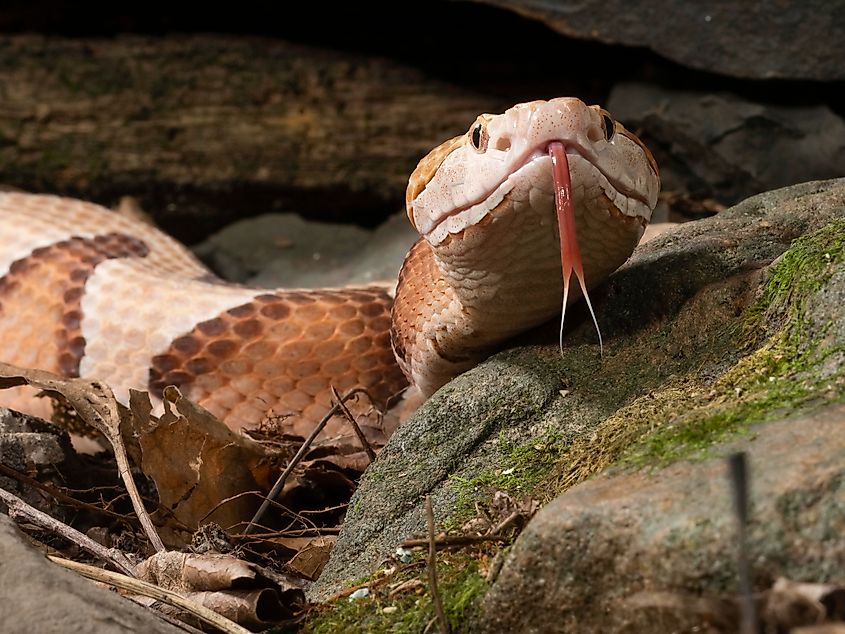
The Southern Copperhead is yet another member of the Copperhead family, designated as Agkistrodon contortrix contortrix. It measures at about 2.5 to 3 feet in length, with the possibility of growing up to 4 feet or 53 inches. These snakes are known for their light tan and pinkish-tan pigments, with dark brown and reddish-brown band layers. The Southern Copperhead is similar to others with its hourglass markings and is seen in Alabama, Arkansas, Florida, Georgia, Illinois, Missouri, North Carolina, Oklahoma, and a couple of other states.
It is known for coiling up when threatened and likes to stay defensive, but it sure loves to inflict venomous bites! As a venomous reptile, it can induce pain, swelling, high fevers, and other symptoms, but it is notably less fatal to human life than expected. That being said, newborn Southern Copperheads are just as likely to bite as older ones, so tourists should always be careful around them. These slow movers are prominent around low-lying wetlands, rivers, or ravines, where they can tuck away in litter and log areas covered by branches and brown debris.
Timber Rattlesnake
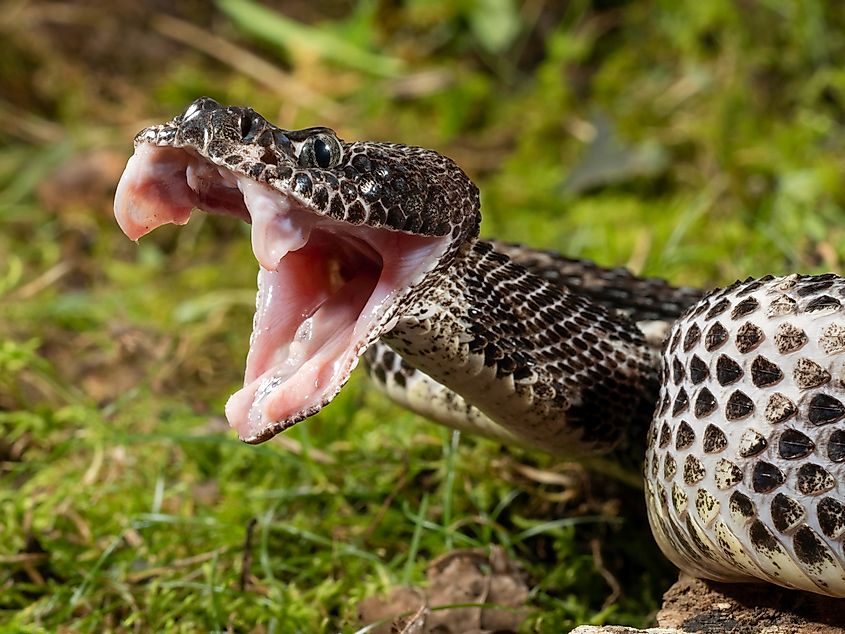
The Timber Rattlesnake (Crotalus horridus) is no stranger to travelers, as it is a thick-bodied reptile with 3 to 5-foot lengths that can reach up to 6 feet at times. Timbers are recognizable by their yellowish-brown tints, dark black botches, velvet tails, and dark stripes descending and backward near the jawline. They can be discovered nearly anywhere on the eastern coast of the U.S. but also stretch to other states.
It has quite a venomous bite that can create severe or fatal reactions among humans and prey alike, such as bleeding, vomiting, lightheadedness, and even drooling or collapsing. These snakes are fans of common spring and summer habitats to move around easily and love rock crevices, forest floors, and warm roads. As they are highly venomous to humans, they should never be provoked or threatened at any point. For diets, they mainly love eating small mammals and birds, with adults having a penchant for large fox squirrels. One may find plenty of newborn and young Timbers slithering about during the months of late August and early September.
Western Cottonmouth

Agkistrodon piscivorus leucostoma, commonly known as the Western Cottonmouth or Water moccasin, is thick-bodied like others on this list, but maintains complexions of saw-like edges and bands difficult to see with the naked eye. These snakes are visible with their lighter cream pinstripes, big white mouths, and elliptical pupils, and do stand out with massive triangular heads that make it easy to confuse with Floridian species or other dark-colored snakes near bodies of water.
While found in Oklahoma, these Cottonmouths are also seen in other southeastern states like Alabama, Georgia, Illinois, Indiana, Kentucky, Louisiana, Mississippi, Missouri, Tennessee, and Texas. The Western Cottonmouth is situated near lakes, ponds, rivers, and swamps, and their selective lifestyle includes the consumption of carrion, frogs, lizards, and even catfish or bats. Aggressive by nature and able to retaliate quickly if provoked, these venomous species are easy predators to many. They are not averse to confrontation, using foul-smelling musks and injecting venom, which can lead to internal bleeding or extreme pain. These Cottonmouths like to inject a single bite and squeeze their prey thoroughly before swallowing them.
Western Diamondback Rattlesnake
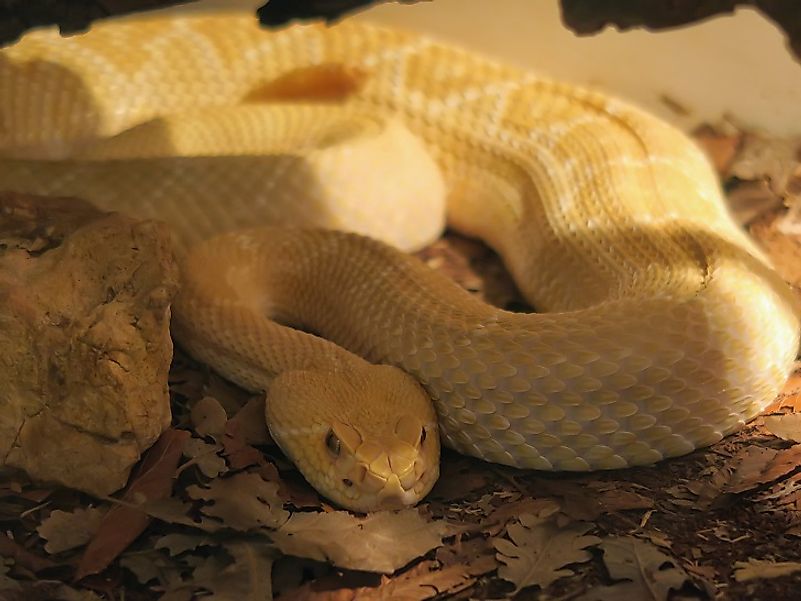
Western Diamondback Rattlesnakes, or Crotalus atrox, measure 3 to 5 feet long and can grow up to 7 feet. Known to be one of the largest rattlesnakes in the western U.S., these reptiles are quite scary! Even with their heavy bodies and diamond-backed patterns, their dark cheek stripes are quite noticeable. Most commonly found in Arizona, Arkansas, California, Oklahoma, Texas, and New Mexico, these rattlesnakes are quite a sight and are most often seen around dry mountain areas and prairies, as well as rocky canyon tourist zones.
These snakes have deadly bites, so it is important to convey that they like to ambush their victims when least expected, especially small mammals and ground-dwellers like rodents. These predators like to hunt within burrows and can directly impact animal habitats quickly using their venomous fangs. One sting from these serpents can induce pain, blisters, necrosis, muscle damage, headaches, convulsions, and even face twitches. The Western Diamondback Rattlesnake is a heat-sensing menace among locals and newcomers.
Western Massasauga
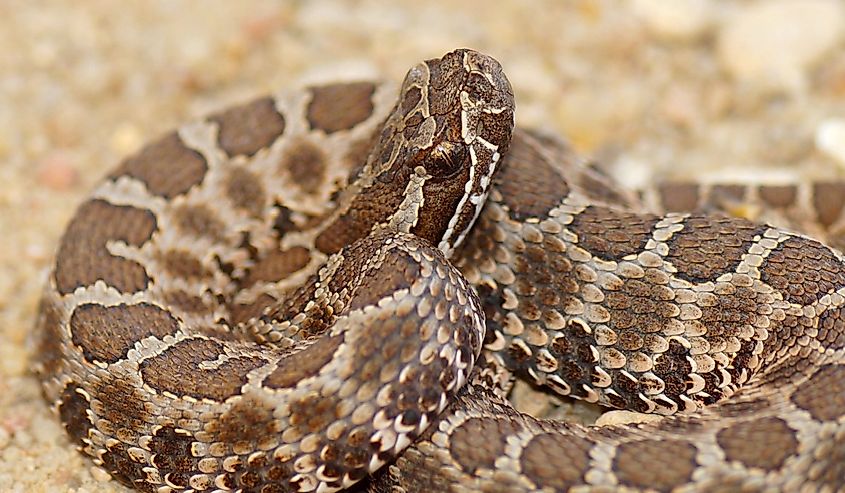
The Western Massasauga or Sistrurus catenatus terminus is a light grey snake with 1.5 to 2.5-foot lengths that is observable with its white or cream features and scattered black markings. Similar to species like the Timber Rattlesnake, these types have diagonal cheek stripes going down and backward near the jaw. They like using their rattling tails to signal for noise and disruption and are hungry for frogs, lizards, and rodents.
These primitive southwestern rattlesnakes are similar to other pit vipers with their elliptical pupils and are found in states like Colorado, Iowa, Kansas, Missouri, Nebraska, Oklahoma, and Texas. Their usual habitats are marshy areas and wetlands near river deltas; this explains why they are referred to as "swamp dwellers" and "great river mouths." While one can find these reptiles in undisturbed places, care should always be taken as their bites are venomous and can cause severe pain and drooling, as well as breathing difficulties.
Western Pygmy Rattlesnake
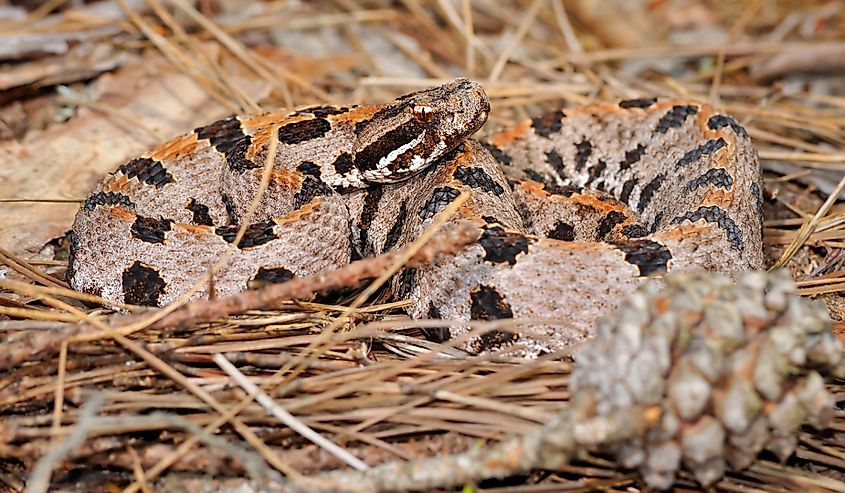
Western Pygmy Rattlesnakes (Sistrurus miliarius streckeri), also called "Ground Rattlers," are red or rusty-colored reptiles that have red stripes and a rattle that is somewhat quiet or unhearable from a distance. It is unique in that it possesses nine enlarged head scales, unlike most rattlesnakes. This snake is a fierce 1 to 2-foot length creature that can be discovered around the states of Alabama, Arkansas, Louisiana, Oklahoma, Mississippi, Missouri, Kentucky, Texas, and Tennessee.
As part of its diet, it prefers most common insects seen in other entries on this list, but also consumes their own kind and giant desert centipedes or mice. The main habitats of these species include mixed pine-hardwood forests, cypress ponds, and marshland areas. These venomous rattlers are fans of injecting hemotoxins that can result in painful bruises, fluid-filled blisters, hemorrhages, or even nausea. As always, humans can be startled if there is any disruption within rattlesnake habitats.
Conclusion
These snakes may have a presence in many states around the U.S., but Oklahomans and travelers looking to explore the "Sooner State" may be in for a reptilian surprise. With so many habitats and surroundings for venomous critters to be around, one may find a lot of unexpected visits from slithering species all throughout their time in Oklahoma. With this list as a reference, tourists can stay abreast of what may be lurking around!











